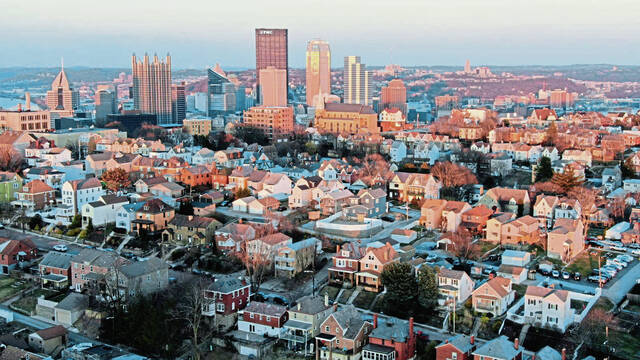Allegheny County had nation's 10th biggest population loss, census estimates show
Allegheny County is among the biggest population losers in the country, according to census estimates released Thursday.
The county’s population dropped by 12,192 people between July 2021 and July 2022, the estimates show. Its estimated population stood at 1,233,253 on July 1, the census said.
The decrease was the 10th largest in the country, according to the census. Los Angeles County was the biggest loser, shedding more than 90,000 residents, followed by Cook County in Illinois; Queens, Kings and Bronx counties in New York; Philadelphia County; Wayne County in Michigan; and Santa Clara and Alameda counties in California.
Allegheny County Executive Rich Fitzgerald said he was surprised by the county’s large population loss because it has low unemployment, tens of thousands of job vacancies, a hot real estate market and recent high retail sales.
“It is something that we really need to look at,” Fitzgerald said. “Why did you move from Pittsburgh and Allegheny County to Florida and Texas? We need to find out why.”
Fitzgerald speculated that the popularity of remote work could be attracting people to outlying counties in the area, noting that two counties bordering Allegheny County — Butler and Washington — experienced growth last year. He also noted that other large counties suffered population losses, pointing to Philadelphia, which lost more than 22,000 residents, according to estimates.
The Pittsburgh region as a whole saw its population decline for the second straight year, according to the census estimates.
The population of the 10-county Southwestern Pennsylvania region fell by 17,516 people between July 2021 to July 2022.
Aside from Allegheny County, the region’s second-largest county, Westmoreland County, shed 1,708 residents. While Butler and Washington counties experienced growth, they added only about 900 residents combined.
Chris Briem, regional economist at Pitt’s Center for Social and Urban Research, said the Pittsburgh region is experiencing its typical trends of natural population decline (more deaths than births) and a small trickle of immigrants moving to the region.
He said those two issues are becoming more common across the country.
“Nationally, these two trends are catching up everywhere,” Briem said.
Census estimates showed that 2,336 counties — nearly three-quarters of the counties in the United States — had a natural population decrease from 2021 to 2022.
“The incidence of natural decrease remains historically high,” reads a census news release.
All 10 counties in the Pittsburgh region saw natural population declines, with over 10,000 more deaths than births. This is not a new trend. Last year, the Pittsburgh region led the nation in natural population decline.
Westmoreland County, with a population 352,057, had 2,378 more deaths than births. Its natural population decline easily eclipsed the 873 residents it added from migration.
Briem said among outlying counties in major metropolitan areas, Westmoreland is one of the oldest in average age. He said before the pandemic hit, all the leading counties with natural population decline were in Florida, except for Westmoreland.
Allegheny County also had a natural decrease (-2,876) but was hit especially hard by domestic migration losses — more American residents moved out of the county than moved into it. Allegheny County’s net domestic migration loss was about 12,000 between 2021 and 2022.
Beaver, Fayette, Greene and Lawrence counties also saw domestic migration losses, while Armstrong, Butler, Washington and Westmoreland counties saw domestic migration increases, meaning they had more residents move in than move out.
Briem said Butler and Washington have historically been the counties attracting people moving within the region, as well as new arrivals, because of their new housing growth.
“Newer development and newer growth,” Briem said.
Fitzgerald said even with the large losses, there are still pockets of growth in the region. He said that in some urban neighborhoods like the Strip District, there is high housing demand.
“Look in certain neighborhoods, and maybe it is isolated, but you see this vibrancy,” he said.
Data breaking down population estimates by municipality should be released in May, according to the U.S. Census.
The last two years of census estimates counter numbers from the full, 10-year census figures in 2020 that showed Allegheny County and the region increasing in population.
Briem said it’s likely that the region and county experienced that growth at the front end of the 2010s. He said the combination of the natural gas boom of the early 2010s and Pittsburgh being hit less hard by the Great Recession could have been attracting people to move to and stay in the region. But that was likely short lived, and national economic factors and fracking dying down placed Southwestern Pennsylvania back into its typical trends.
“The story is not where we are going to turn these trends around. The story is whether our trends will expand to more U.S. regions,” Briem said.
Ryan Deto is a TribLive reporter covering politics, Pittsburgh and Allegheny County news. A native of California’s Bay Area, he joined the Trib in 2022 after spending more than six years covering Pittsburgh at the Pittsburgh City Paper, including serving as managing editor. He can be reached at rdeto@triblive.com.
Remove the ads from your TribLIVE reading experience but still support the journalists who create the content with TribLIVE Ad-Free.

